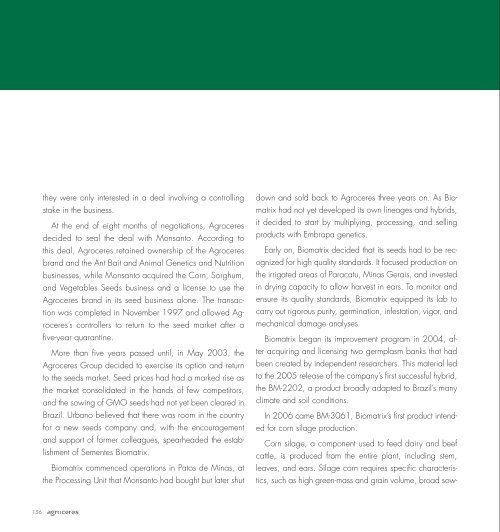Livro Agroceres
- No tags were found...
You also want an ePaper? Increase the reach of your titles
YUMPU automatically turns print PDFs into web optimized ePapers that Google loves.
they were only interested in a deal involving a controlling<br />
down and sold back to <strong>Agroceres</strong> three years on. As Bio-<br />
ing season adaptability, good leaf sanity, and high nutrient<br />
event was also authorized. Bt technology was coming to<br />
stake in the business.<br />
matrix had not yet developed its own lineages and hybrids,<br />
and fiber digestibility.<br />
change the Brazilian corn seeds market, and Biomatrix was<br />
At the end of eight months of negotiations, <strong>Agroceres</strong><br />
decided to seal the deal with Monsanto. According to<br />
this deal, <strong>Agroceres</strong> retained ownership of the <strong>Agroceres</strong><br />
brand and the Ant Bait and Animal Genetics and Nutrition<br />
businesses, while Monsanto acquired the Corn, Sorghum,<br />
and Vegetables Seeds business and a license to use the<br />
<strong>Agroceres</strong> brand in its seed business alone. The transaction<br />
was completed in November 1997 and allowed <strong>Agroceres</strong>’s<br />
controllers to return to the seed market after a<br />
five-year quarantine.<br />
it decided to start by multiplying, processing, and selling<br />
products with Embrapa genetics.<br />
Early on, Biomatrix decided that its seeds had to be recognized<br />
for high quality standards. It focused production on<br />
the irrigated areas of Paracatu, Minas Gerais, and invested<br />
in drying capacity to allow harvest in ears. To monitor and<br />
ensure its quality standards, Biomatrix equipped its lab to<br />
carry out rigorous purity, germination, infestation, vigor, and<br />
mechanical damage analyses<br />
Biomatrix began its improvement program in 2004, af-<br />
The success of BM-3061 helped the company realize the<br />
importance of the silage segment in Brazil. Together with<br />
<strong>Agroceres</strong> Multimix and specialized consultants, Biomatrix<br />
started to include nutritional quality tests in its improvement<br />
program and launched a cycle of technical lectures on silage<br />
intended for customers and for its own technical service<br />
people. As a result, it attained a high market share in the<br />
segment, with BM-3061 itself and the subsequent release of<br />
new products, such as BM-3063, BM-3066, SHS 4070,<br />
SHS 7920, and SHS 7990.<br />
quick to respond. It struck an agreement with Dow to sell<br />
Herculex products and another with Monsanto to introduce<br />
the VTPRO-2 gene in its own germplasm.<br />
In mid-2011, Biomatrix expanded its seeds business by<br />
acquiring the operations of Santa Helena Sementes, a traditionally<br />
established company founded in the 1980s. The<br />
acquisition brought in an experienced team, 14 hybrids<br />
with Santa Helena’s own genetics, an extensive hybrids and<br />
lineages development program, and a wide-ranging commercial<br />
network that covered the entire country and some<br />
More than five years passed until, in May 2003, the<br />
<strong>Agroceres</strong> Group decided to exercise its option and return<br />
to the seeds market. Seed prices had had a marked rise as<br />
the market consolidated in the hands of few competitors,<br />
and the sowing of GMO seeds had not yet been cleared in<br />
Brazil. Urbano believed that there was room in the country<br />
for a new seeds company and, with the encouragement<br />
and support of former colleagues, spearheaded the establishment<br />
of Sementes Biomatrix.<br />
ter acquiring and licensing two germplasm banks that had<br />
been created by independent researchers. This material led<br />
to the 2005 release of the company’s first successful hybrid,<br />
the BM-2202, a product broadly adapted to Brazil’s many<br />
climate and soil conditions.<br />
In 2006 came BM-3061, Biomatrix’s first product intended<br />
for corn silage production.<br />
Corn silage, a component used to feed dairy and beef<br />
cattle, is produced from the entire plant, including stem,<br />
Still, Biomatrix was not limited to silage. In 2007, it<br />
launched the BM-810, which soon came in first in the Ma<br />
Shou Tao competition field in Conquista, Minas Gerais, at<br />
12,139 kg/ha. Today, products like BM-709 and SHS-<br />
7990 go as high as 13,000 kg/ha in the summer and<br />
9,000 kg/ha in the second harvest, rivaling the productivity<br />
of the market’s best known brands.<br />
In 2007, CTNBio – the Federal agency in charge of<br />
GMO products regulation in Brazil – authorized sales of<br />
South American markets. When the two brands merged,<br />
Biomatrix decided to change its corporate name to Helix<br />
Sementes, which is now the biggest Brazilian-controlled<br />
corn and sorghum seeds company.<br />
The company has three research stations in subtropical<br />
Passo Fundo, Rio Grande do Sul; in high-altitude tropical<br />
Patos de Minas, Minas Gerais; and in low-altitude tropical<br />
Ipiaçu, Minas Gerais. It has used haploidy technology to<br />
create lineages since 2010 and carries out experimental<br />
Biomatrix commenced operations in Patos de Minas, at<br />
leaves, and ears. Silage corn requires specific characteris-<br />
the first Bt genetically modified event in Brazil, Monsanto’s<br />
assays at 44 sites in eight Brazilian states to test its hybrids.<br />
the Processing Unit that Monsanto had bought but later shut<br />
tics, such as high green-mass and grain volume, broad sow-<br />
YieldGard. Soon thereafter, in 2008, Dow’s Herculex Bt<br />
Recently, its broad genomic selection project was approved<br />
156<br />
157


